lock AUDI A3 2015 Workshop Manual
[x] Cancel search | Manufacturer: AUDI, Model Year: 2015, Model line: A3, Model: AUDI A3 2015Pages: 288, PDF Size: 71.46 MB
Page 181 of 288
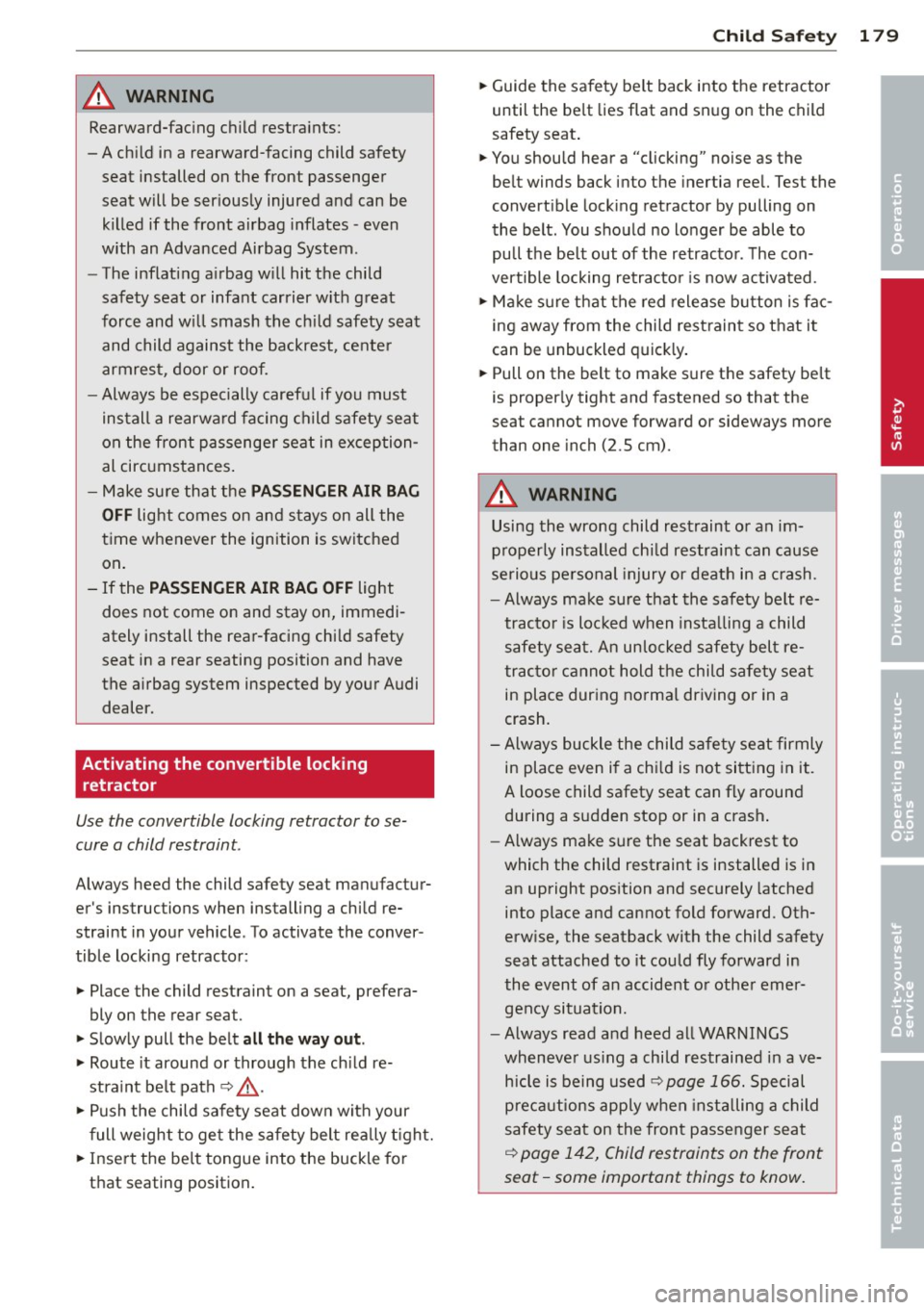
A WARNING ,~
Rearward-facing ch ild restraints:
-A chi ld in a rearward-facing child safety
seat installed on the front passenger
seat will be ser iously injured and can be
killed if the front airbag inflates -even
with an Advanced Airbag System .
- The inflating a irbag w ill hit the child
safety seat or infant carrier w ith great
force and w ill smash the ch ild safety seat
and child against the backrest, cente r
armrest, door or roo f.
- Always be especially caref ul if you must
install a rearwa rd fa cing child safety seat
on the front passenge r sea t in exception
al circumstances .
- Make su re that the
PASSENGER AIR BAG
OFF
light comes on and s tays on all the
time whenever the ignition is switched
on .
- If the
PASSENGER AIR BAG OFF light
does not come on and stay on, immedi
ately install the rea r-facing chi ld safety
seat in a rear seating position and have
the a irbag system inspected by you r Audi
dealer.
Activating the convertible locking retractor
Use the convertible locking retractor to se
cure a child restraint.
Always heed the child safety seat manufactur
er's instructions when install ing a chi ld re
straint in your vehicle . To activate t he conver
tible locking retracto r:
.,. Place the child restraint on a seat, prefera
bly on the rear sea t.
.,. Slow ly pull the be lt
all the way out .
.. Route it around or through the ch ild re
st ra int be lt path ¢&, .
.,. Push the child safety seat dow n with your
f ull weight to ge t the safety belt really t ight.
.,. Insert the be lt tongue into the buckle for
that seating position .
Child Safet y 1 79
.,. Guide the sa fe ty be lt back into the retractor
until the be lt lies flat and sn ug on the child
safety seat .
.,. You shou ld hear a "clicking" noise as the
be lt winds back into the iner tia ree l. Test the
convert ible lock ing retractor by pulling on
the belt. You sho uld no lo nger be able to
pull the be lt out of the retracto r. T he con
ver tible locking re trac to r i s now ac tiva ted .
.,. Mak e s ure t hat t he red release b utton is fac
ing away from the child rest rain t so t hat i t
can be unbuckled q uic kly .
.. Pull on the belt to make sure the safety be lt
is properly tight and fastened so that the
seat cannot move forward or sideways more
than one inch (2 .5 cm).
A WARNING
Using the wrong child restraint o r an im
p roperly installed chi ld restraint can cause
serious pe rsonal injury or death in a crash.
- Always ma ke sure that the safe ty belt re-
tracto r is loc ked when insta lling a child
safety seat. An unlocked safety belt re
tracto r can not hold the child safety seat
in place dur ing no rma l driving o r in a
cras h.
- Always buckle the child sa fe ty seat firmly
in place even i f a ch ild is not sitt ing in it.
A loose child safety seat can fly aroun d
during a sudden stop or in a crash .
- Always ma ke s ure the seat backrest to
which the child restraint is installed is in
an upright pos ition and securely latched
into place and can not fold forward . Oth
erw ise, the seatback with the child safety
seat attached to it could fly forward in
the ev ent of an accident o r othe r emer
gency situatio n.
- Always read a nd heed al l WAR NINGS
wheneve r us ing a child restrained in ave
hicle is being used ¢
page 166. Special
pre cau tions apply whe n inst alling a child
safety sea t on the fron t passenger seat
¢ page 142, Child restraints on the front
seat -some important things to know.
-
•
•
•
Page 182 of 288
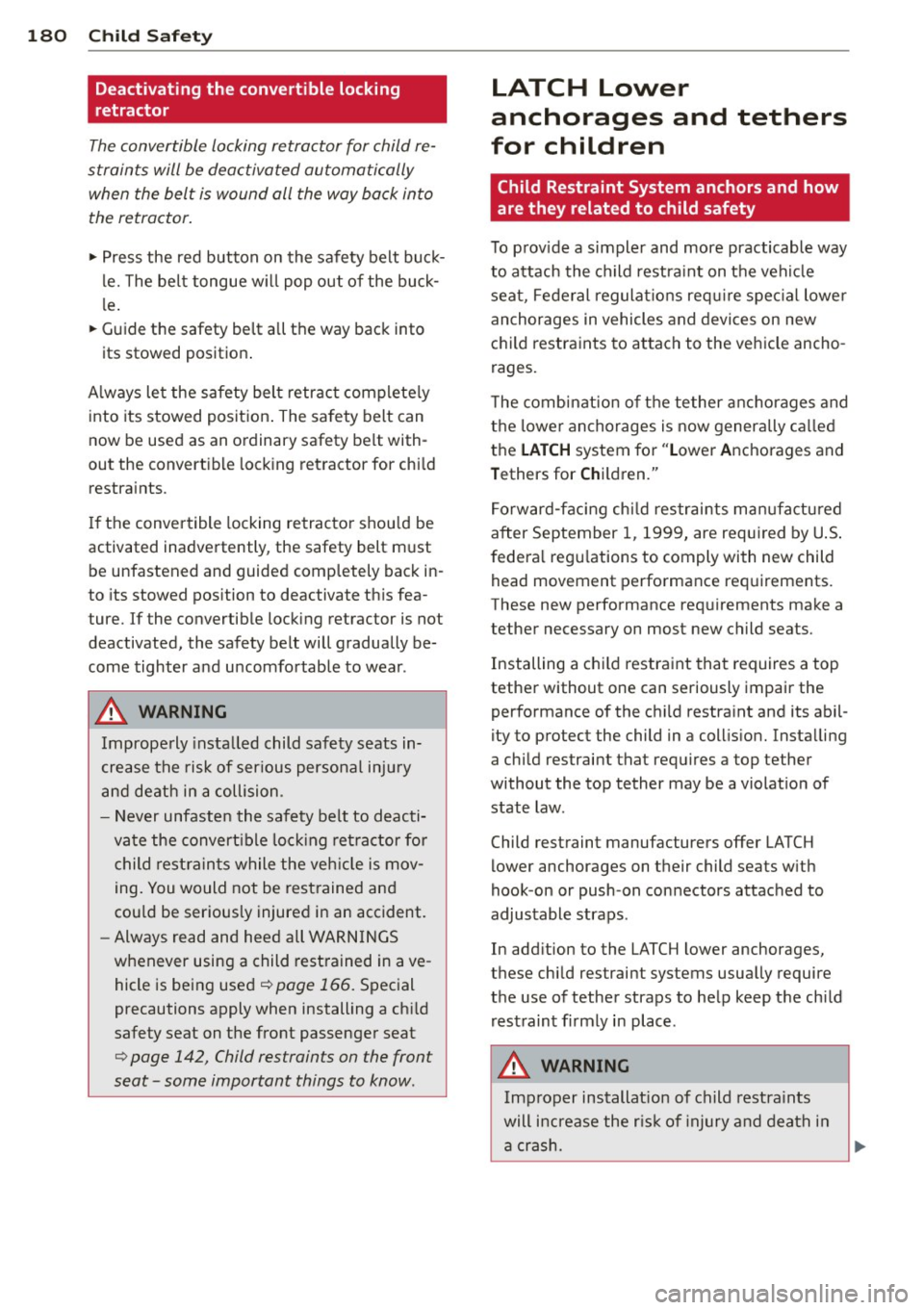
180 Child Saf ety
Deactivating the convertible locking
retractor
The convertible locking retractor for child re
straints will be deactivated automatically when the belt is wound all the way back into the retractor .
.,. Press the red button on the safe ty belt buck
le. The be lt tongue w ill pop out of the buck
le .
.. Guide the safety be lt all the way back into
its stowed position .
A lways le t the safety bel t retract comp lete ly
into its stowed posit ion . The sa fety belt can
now be used as an ordinary safety belt with
out the convert ib le locking ret ractor for chi ld
restra ints.
If the convertible locking retracto r shou ld be
activated inadvertently, the safety belt m ust
be unfastened and guided comp letely back in
to its stowed pos ition to deactivate th is fea
ture. If the convertib le locki ng retractor is not
deactivated, the safety be lt will gradually be
come tighter a nd u ncomfo rtable to wea r.
A WARNING
Imprope rly insta lled child saf ety seats in
crease t he risk of ser ious personal inju ry
a n d death in a collision .
- Never unfaste n the safety belt to deacti
vate the convert ible lo cking re tr actor fo r
ch ild rest rain ts while the veh icle is mov
ing. You would not be res trained and
cou ld be seriously injured in an accident.
- Always re ad and heed all WARN INGS
whenever using a child rest rained in ave
hicle is being used¢
page 166. S pecial
precautions apply when installing a ch ild
safety seat on the front passenge r seat
¢ page 142, Child restraints on the front
seat -some important things to know.
LATCH Lower
anchorages and tethers
for children
Child Restraint System anchors and how
are they related to child safety
T o p rov ide a simple r and more practicable way
to a ttach the child restra int on t he vehi cle
sea t, Federal regulat ions re quire spe cial lowe r
anchorages in vehicles and devices on new
c h ild restraints to attach to the vehicle ancho
rages.
T he comb inat io n of th e tether anc horages and
the lowe r anchorages is now genera lly c alled
t h e
LATCH system fo r "Lower Anchorages and
T ethers for Child ren."
F o rward-f ac ing ch ild res trai nts ma nufacture d
after September 1, 1999, are req uired by U .S .
f ede ra l regu lations to comply with new child
head movement performance req uirements.
These new performance req uirements make a
tether necessary on most new child seats.
Installing a child restraint that requires a top
tethe r without one can seriously impair the
performance of the c hild restra int and its abil
ity to protect the child in a coll is ion. Insta lling
a chi ld restrai nt that requires a top tether
without the top tether may be a violat ion of
state law.
Child rest raint manufacturers offer LATCH
lower anchorages on their child seats w ith
hook-on or push-on connectors attached to
adjustable straps .
In add ition to the LATCH lower anchorages,
t h ese chi ld restraint systems usually require
t h e use of tethe r straps to he lp keep the ch ild
rest raint fi rmly in place.
A WARNING
-Imp roper installat ion of ch ild restra ints
will i ncrease the r is k of injury a nd dea th i n
a cr ash.
-
Page 184 of 288
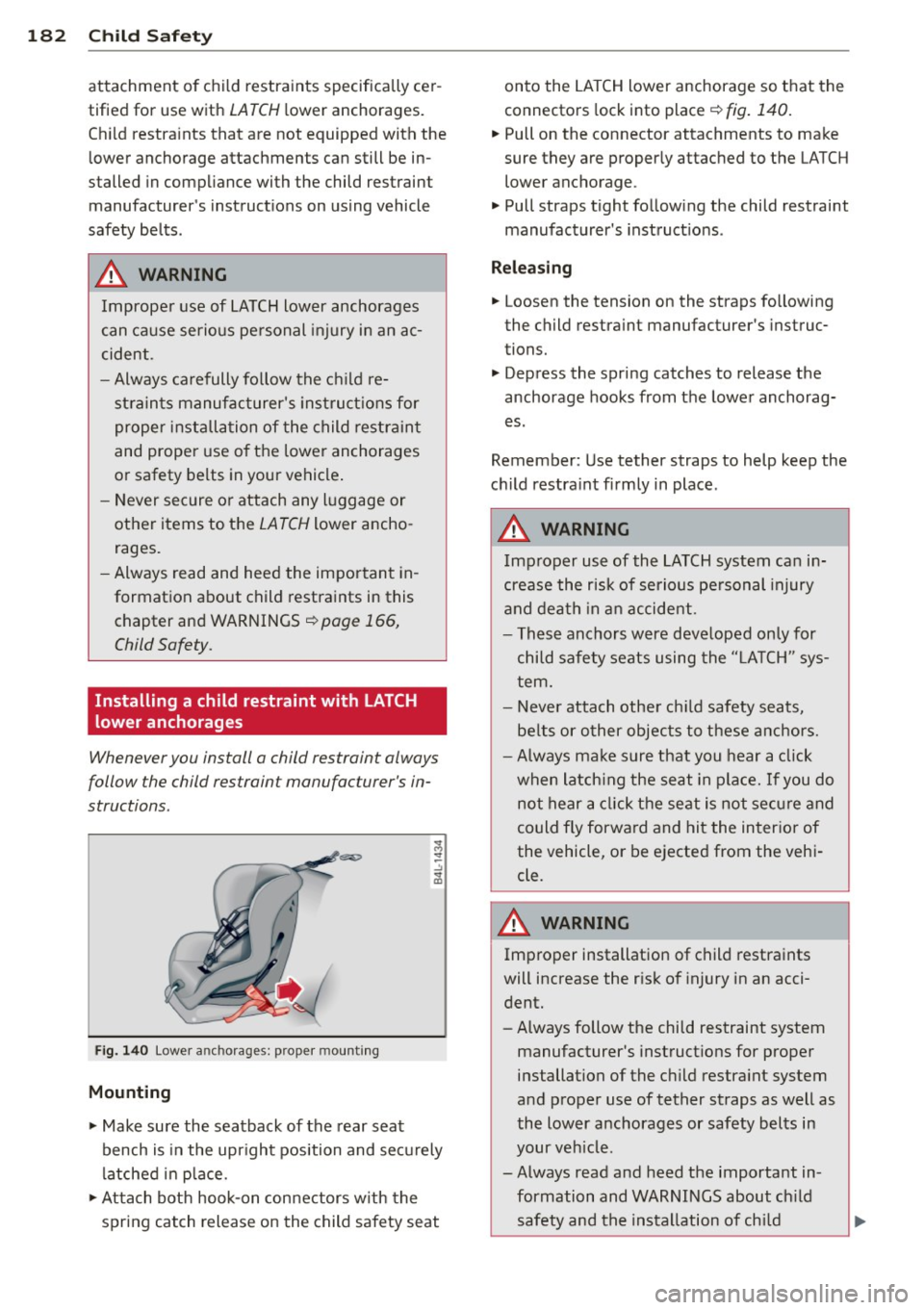
182 Child Saf ety
attachment of child restraints specifically cer
tified for use with
LATCH low er anchorages.
Ch ild restra ints that are not equipped with the
lower anchorage attachments can still be in
stalled in comp liance with the child restrain t
manufacturer's instruct ions on using vehicle
safety belts .
A WARNING
Improper use of LATCH lower anchorages
can ca u se serio us pe rsonal inju ry i n an ac
c ident .
- Always ca refully fo llow the c hild re
st raints manuf acturer's inst ru cti ons for
proper ins tallat ion of the child rest rain t
and proper use of the lowe r anchorages
or safety be lts in your vehicle .
- Never secure or attach any l uggage or
other items to the
LATCH lower ancho
rages.
- Always read and heed the impor tant in
format ion about child restraints in this
chapter and WARNINGS
<=> page 166 ,
Child Safety.
Installing a child restraint with LATCH
lower anchorages
Whenever you install a child restraint always
follow the child restrain t manufacturer's in
structions .
Fig. 14 0 Lower a nch orage s: p roper mou ntin g
Mounting
.. Make sure the seatback of the rear seat
bench is in the upr ight position and se curely
l atched in place.
.. At tach both hook -on con nectors w ith the
spring catch release on the child safety seat onto the LATCH lower anchorage so that the
connectors
lock into place¢
fig. 140 .
.. Pull on the connector attachments to ma ke
sure they are properly attached to the LATCH lower anchorage .
.. Pull straps tight fo llow ing the child restraint
manufacturer's instruct ions .
Releasing
.. Loosen the tension on the straps following
the child restra int manufacturer's instruc
tions.
.. Depress the spri ng catches to release the
anchorage hooks from the lowe r anchorag
es .
Remember: Use tether straps to help keep the
c h ild restra int firm ly in place .
A WARNING
--Improper use of the LATCH system ca n in -
crease the risk of serious pe rsonal injury
a nd dea th in a n accident.
- T hese anchors were deve loped only for
chi ld safety seats using the "LATCH" sys
tem.
- Neve r attach othe r chil d safety seats,
be lts or o ther object s to these ancho rs.
- Always make sur e that you hear a c lick
when latch ing the seat in p la ce. If you do
no t hear a click t he se at i s not se cure and
could fly forwa rd and hit the in ter ior of
the vehicle, or be ejected from the veh i
cle.
A WARNING ~
Improper installat ion of child restra ints
will increase the risk of in jury in an acci
dent.
- Always follow the chi ld restraint system
manufacturer's instruct ions for proper
installation of the c hild restra int system
a nd p roper use of tether straps as well as
the lower a nchorages or safety belts in
your veh icle.
- Always read a nd heed t he importa nt in
formation and WARNINGS about ch ild
safety and the insta llation of ch ild
-
Page 187 of 288
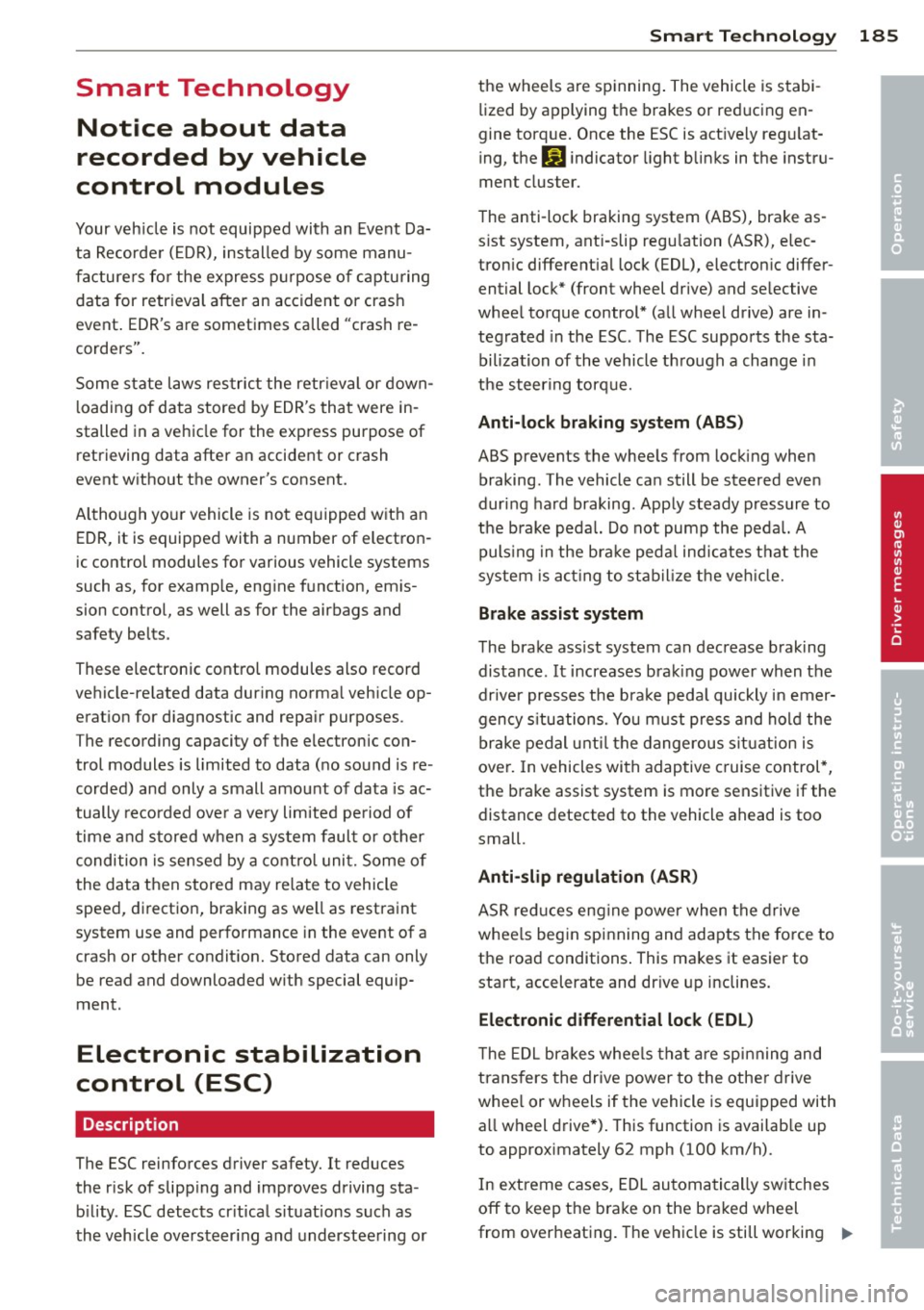
Smart Technology Notice about data
recorded by vehicle
control modules
Your veh icle is not equipped with an Event Da
ta Recorde r (EO R), installed by some manu
facture rs fo r the express purpose o f capturing
data for retr ieval after an accident or cras h
event . EDR's a re sometimes called "crash re
corders".
Some state laws res trict the retr ieval or down
l oadi ng of data stored by E DR's that were in
stalled in a veh icle for the exp ress purpose of
retrieving data after an accide nt or crash
event w ithout the owner's consent.
A lthough yo ur vehicle is no t equ ipped w it h an
EDR, it is equipped with a number of elect ron
ic control modules fo r various vehicle systems
such as, for examp le, eng ine f unction, em is
sion control, as well as for the airbags and
safety belt s.
These electronic contro l modules also record
veh icle -re lated data dur ing no rma l veh icle op
erat ion for d iagnostic and repa ir purposes .
T he recording capacity of the electronic con
trol modules is limited to data (no sound is re
corded) and only a small amount of data is ac
tually recorded ove r a ve ry limited pe riod of
time and stored when a sys tem faul t or o ther
condition is se nse d by a cont rol u nit. Some o f
the data then stored may re la te to vehicle
speed, dir ect io n, bra king as we ll as restra int
system use and perfo rmance in the event of a
crash or other condit ion. Stored data can only
be read and downloaded w ith special equip
ment.
Electronic stabilization
control (ESC)
Description
The ESC reinforces driver safety. It reduces
the r isk of slipp ing and improves driving sta
b ili ty . E SC detects cr itical s it u ations such as
the veh icle ove rsteer ing and understee ring or
Smart Technolog y 185
th e wheels a re sp inning . The vehicle is stabi
li zed by applying the brakes or red ucing en
gine torq ue. Once the ESC is act ive ly reg ulat
ing, the
G) i ndicato r light b links in the instru
ment cluster.
The anti-lock braking system (ABS), brake as s ist system, ant i-slip regu lation (ASR), e lec
tron ic different ia l loc k (EDU, electron ic differ
ential lock* (front wheel drive) and se lective
whee l to rque control* (a ll whee l drive) are in
teg rated in the ESC. The ESC suppo rts the sta
bilization of the vehicle th rough a change in
t h e s teer ing torq ue.
Anti-lock braking system (ABS)
ABS prevents the whee ls from locking when
braking . The vehicle ca n still be steered even
dur ing ha rd braking. App ly steady pressure to
the b rake peda l. Do not pump the p edal. A
puls ing in the bra ke peda l indicates t hat the
system is acting to st abil ize the ve hicle.
Brake assist system
The brake ass ist system can decrease braking
dis tance. It increases bra king power when the
drive r presses the bra ke peda l quickly in emer
gency s ituations. Yo u m ust pres s and hol d the
brake pedal unt il the dangerous s it u at ion is
ove r. In vehicles with adap tive c ruise control *,
the b rake assist system is more sensitive if the
distance detected to the vehicle ahead is too
small.
Anti-slip regulation (ASR )
ASR reduces eng ine power when the drive
whee ls beg in spi nning and adapts the fo rce to
the road conditions . This makes it easier to
start, accelerate and dr ive up inclines.
Electronic differential lock (EDL)
The EDL bra kes whee ls tha t a re sp inning and
trans fers the dr ive power to the othe r drive
whee l or w heels if the vehicle is equ ip ped with
a ll w heel d rive*) . This function is availab le up
to approximately 62 mph (100 km/h).
I n extreme cases, EDL au toma tically sw itches
off to keep t he b rake on the bra ked wheel
from overheat ing. The ve hicle is still working .,..
•
•
•
Page 188 of 288
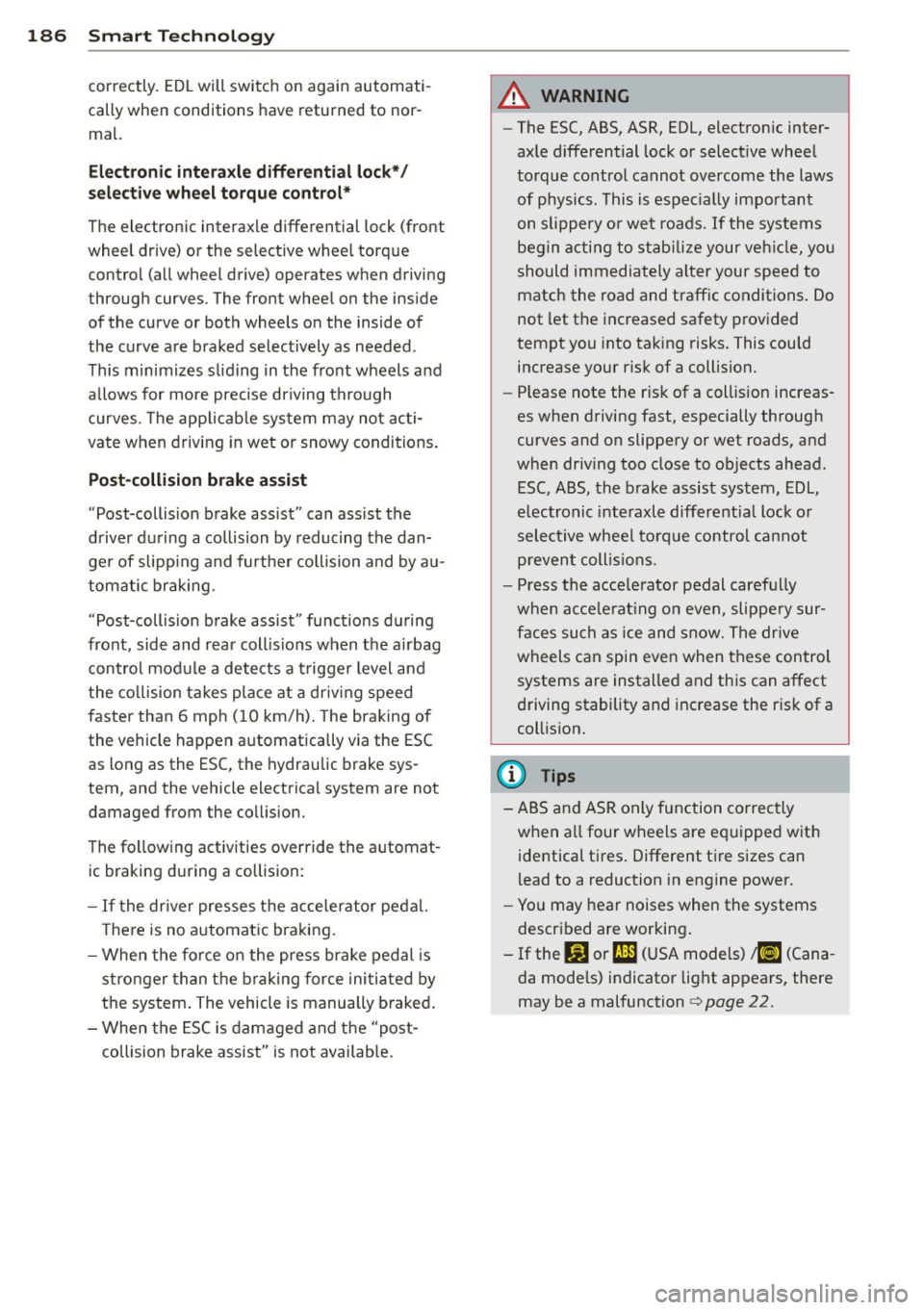
186 Smart T echnol ogy
correctly. ED L will switch on again automati
cally when conditions have returned to nor
mal.
Electroni c inte raxle diff ere ntial lo ck */
s e le ct ive w heel t orqu e cont rol *
The electronic interaxle differential lock (front
wheel drive) or the selective wheel torque
contro l (all wheel drive) operates when driving
through curves. The front whee l on the inside
of the curve or both wheels o n the inside of
the curve are braked selectively as needed .
This minimizes s liding in the front wheels and
a llows for more precise driving through
curves. The app licab le system may not acti
vate when driving in wet or snowy conditions .
Post-collision bra ke ass ist
"Post-collision brake assist" can ass ist the
driver during a collision by reducing the dan
ge r of slipp ing and further co llision and by au
tomatic braking.
"Post-collision brake assist" functions during
front, side and rear collis ions when the a irbag
control module a detects a trigger level and
the co llision takes place at a dr iv ing speed
faster than 6 mph (10 km/h). The braking of
the vehicle happen automatically via the ESC
as long as the ESC, the hydraulic brake sys
tem, and the vehicle electrical system are not
damaged from the coll ision.
The fo llowing activ ities override the automat
ic braking during a collision:
- If the dr iver presses the accelerator peda l.
T here is no a utomatic braking.
- When the force on the press brake pedal is
stronger than the b raking force initiated by
the system . The vehicle is manually braked .
- When the ESC is damaged and the "post
collision brake assist" is not availab le.
A WARNING
- The ESC, ABS, ASR, EDL, electron ic inter
axle d ifferential lock or select ive wheel
torque control cannot overcome the laws
of physics. This is espec ially important
on sl ippery o r wet roads.
If the systems
begin acting to stabili ze your veh icle, you
should immediately alter your speed to
match the road and traffic conditions . Do
not let the increased safety prov ided
tempt you into tak ing risks. This could
increase your risk of a collision.
- Please note the risk of a collision increas
es when driving fast, especially through
curves and on slippery or wet roads, and
when dr iv ing too close to objects ahead .
ESC, ABS, the brake assist system, EDL,
electronic interaxle differentia l lock or
selective whee l to rque control cannot
p revent coll is ions.
- Press the acce lerator pedal carefully
when acce le rat ing o n even, slippe ry sur
f a ces such as ice and snow. The drive
wheels can spin even when these control
systems are installed and this can affect
driving stability and increase the risk of a
col lision.
(D Tips
- ABS and ASR only function correc tly
when all four wheels are eq uipped w ith
identical tires. Different t ire sizes can
lead to a reduction in engine power.
- Yo u may hear noises when the systems
described are working .
- If the
DJ or m] (USA models) !II] (Cana
da mode ls) indicator light appears, there
may be a malfunction
¢ page 22.
Page 191 of 288
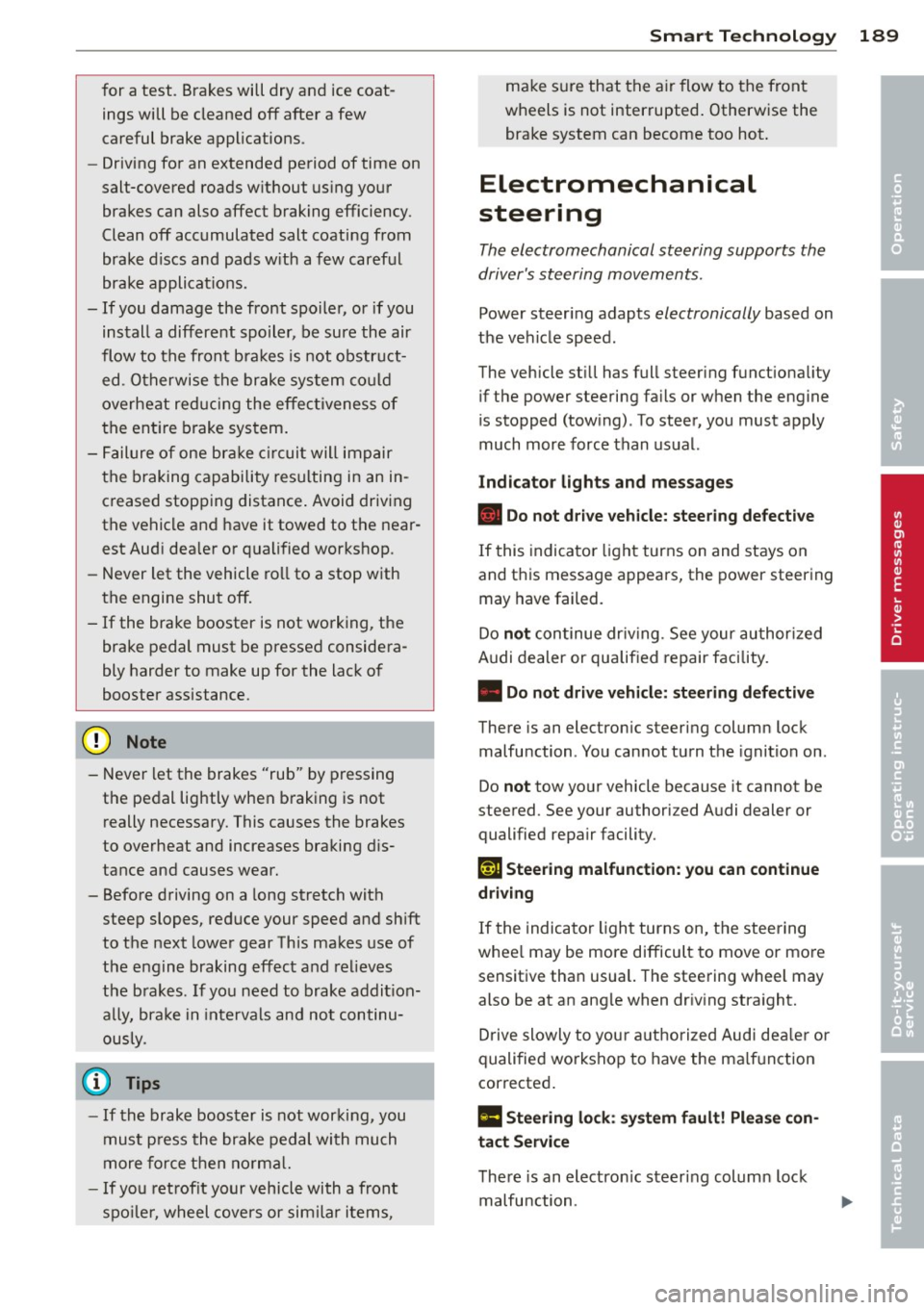
for a test. Brakes will dry and ice coatings will be cleaned off after a few
careful brake applications.
- Driving for an extended period of time on
salt-covered roads without using your
brakes can also affect braking efficiency.
Clean off accumulated salt coating from
brake discs and pads with a few careful
brake applications.
- If you damage the front spoiler, or if you
install a different spoiler, be sure the air
flow to the front brakes is not obstruct
ed. Otherwise the brake system could
overheat reducing the effectiveness of
the entire brake system.
- Failure of one brake circuit will impair
the braking capability resulting in an in
creased stopping distance. Avoid driving
the vehicle and have it towed to the near
est Audi dealer or qualified workshop.
- Never let the vehicle roll to a stop with
the engine shut off.
- If the brake booster is not working, the
brake pedal must be pressed considera
bly harder to make up for the lack of
booster assistance.
(D Note
- Never let the brakes "rub" by pressing
the pedal lightly when braking is not really necessary. This causes the brakes
to overheat and increases braking dis
tance and causes wear.
- Before driving on a long stretch with
steep slopes, reduce your speed and shift
to the next lower gear This makes use of
the engine braking effect and relieves
the brakes. If you need to brake addition
ally, brake in intervals and not continu
ously.
(D Tips
- If the brake booster is not working, you
must press the brake pedal with much
more force then normal.
- If you retrofit your vehicle with a front
spoiler, wheel covers or similar items,
Smart Technology 189
make sure that the air flow to the front
wheels is not interrupted. Otherwise the
brake system can become too hot.
Electromechanical
steering
The electromechanical steering supports the
driver's steering movements.
Power steering adapts electronically based on
the vehicle speed.
The vehicle still has full steering functionality if the power steering fails or when the engine
is stopped (towing) . To steer, you must apply
much more force than usual.
Indicator lights and messages
• Do not drive vehicle: steering defective
If this indicator light turns on and stays on
and this message appears, the power steering
may have failed.
Do
not continue driving . See your authorized
Audi dealer or qualified repair facility.
• Do not drive vehicle: steering defective
There is an electronic steering column lock
malfunction . You cannot turn the ignition on.
Do
not tow your vehicle because it cannot be
steered. See your authorized Audi dealer or qualified repair facility.
c~ij Steering malfunction: you can continue
driving
If the indicator light turns on, the steering
wheel may be more difficult to move or more
sensitive than usual. The steering wheel may
also be at an angle when driving straight.
Drive slowly to your authorized Audi dealer or
qualified workshop to have the malfunction
corrected.
Ill Steering lock: system fault! Please con
tact Service
There is an electronic steering column lock
malfunction.
•
•
•
Page 202 of 288
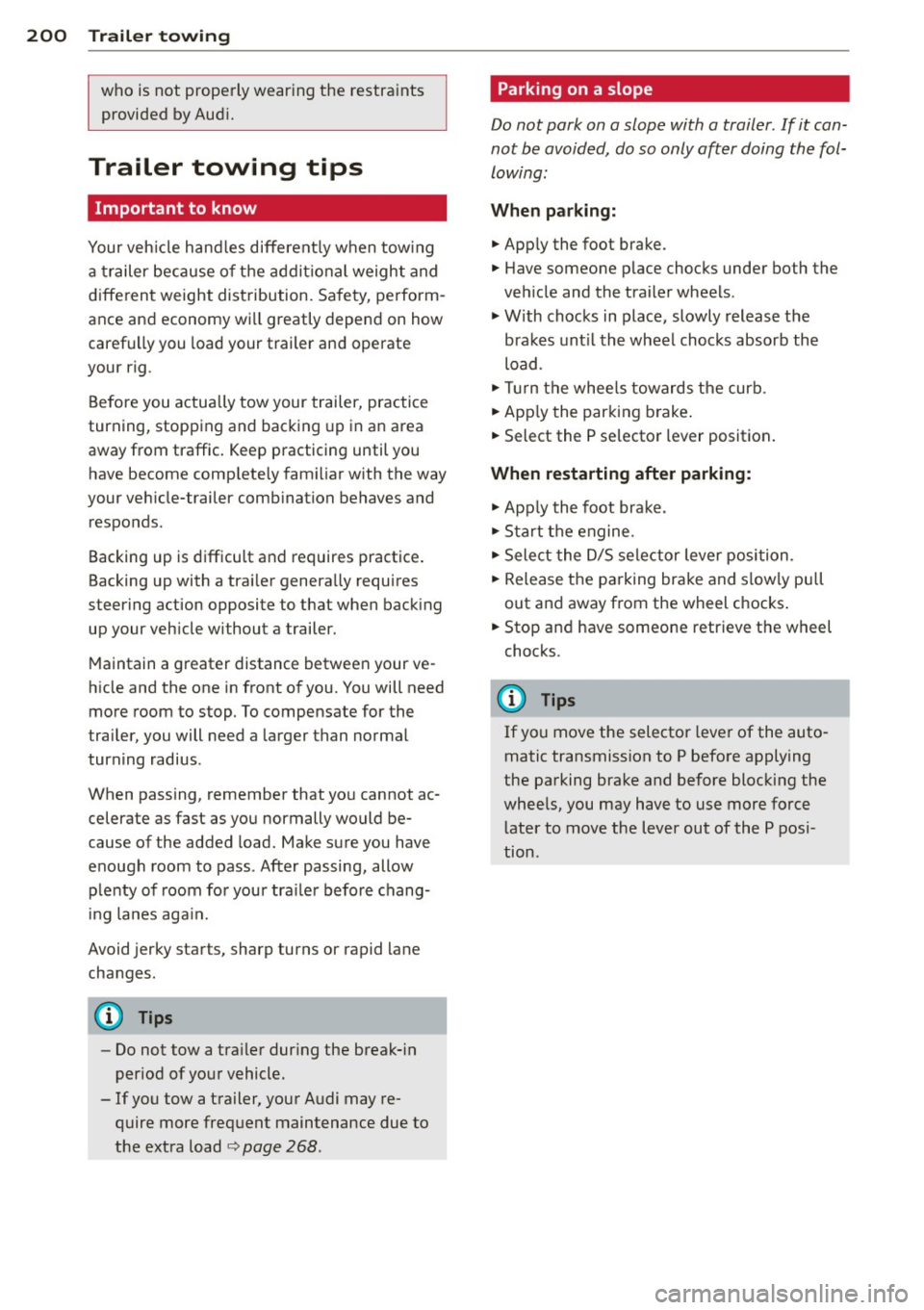
200 Trailer towing
who is not properly wearing the restraints
provided by Aud i.
Trailer towing tips
Important to know
Your vehicle hand les different ly when tow ing
a trailer because of the additional weight and
different weight distribution. Safety, perform
ance and economy wi ll greatly depend on how
carefully you load your trailer and operate
your rig.
Before you actually tow your trailer, practice
turning, stopp ing and backing up in an area
away from traffic. Keep practicing until you have become completely familiar with the way
your vehicle-trailer combination behaves and responds.
Backing up is difficult and requires practice.
Backing up with a trai ler genera lly requires
steering action opposite to that when backing up your vehicle without a trailer.
Maintain a greater distance between your ve
hicle and the one in front of you. You will need
more room to stop. To compensate for the
trailer, you will need a larger than normal
turn ing radius .
When passing, remember that you cannot ac
celerate as fast as you normally would be
cause of the added load. Make sure you have
enough room to pass . After passing, allow
plenty of room for your tra iler before chang
ing lanes aga in.
Avoid jerky starts, sharp turns or rapid lane
changes .
(D Tips
-Do not tow a tra iler during the break-in
period of your vehicle.
- If you tow a trailer, your Audi may re
quire more frequent maintenance due to
the extra load
q page 268.
Parking on a slope
Do not park on a slope with a trailer . If it can
not be avoided, do so only after doing the fol lowing:
When parking:
.. App ly the foot brake.
.. Have someone place chocks under both the
vehicle and the trailer wheels .
.,. With chocks in place, slowly release the
brakes until the wheel chocks absorb the
load.
.. Turn the whee ls towards the curb.
.. App ly the parking brake.
.. Select the P selector lever position.
When restarting after parking:
.. Apply the foot brake .
.. Start the engine .
.. Select the D/S selector lever position.
.. Release the parking brake and s lowly pull
out and away from the wheel chocks .
.. Stop and have someone retrieve the wheel
chocks .
(D Tips
If you move the selector lever of the auto
matic transmission to P before applying
the parking brake and before blocking the
whee ls, you may have to use more force
later to move the lever out of the P posi
tion.
Page 209 of 288
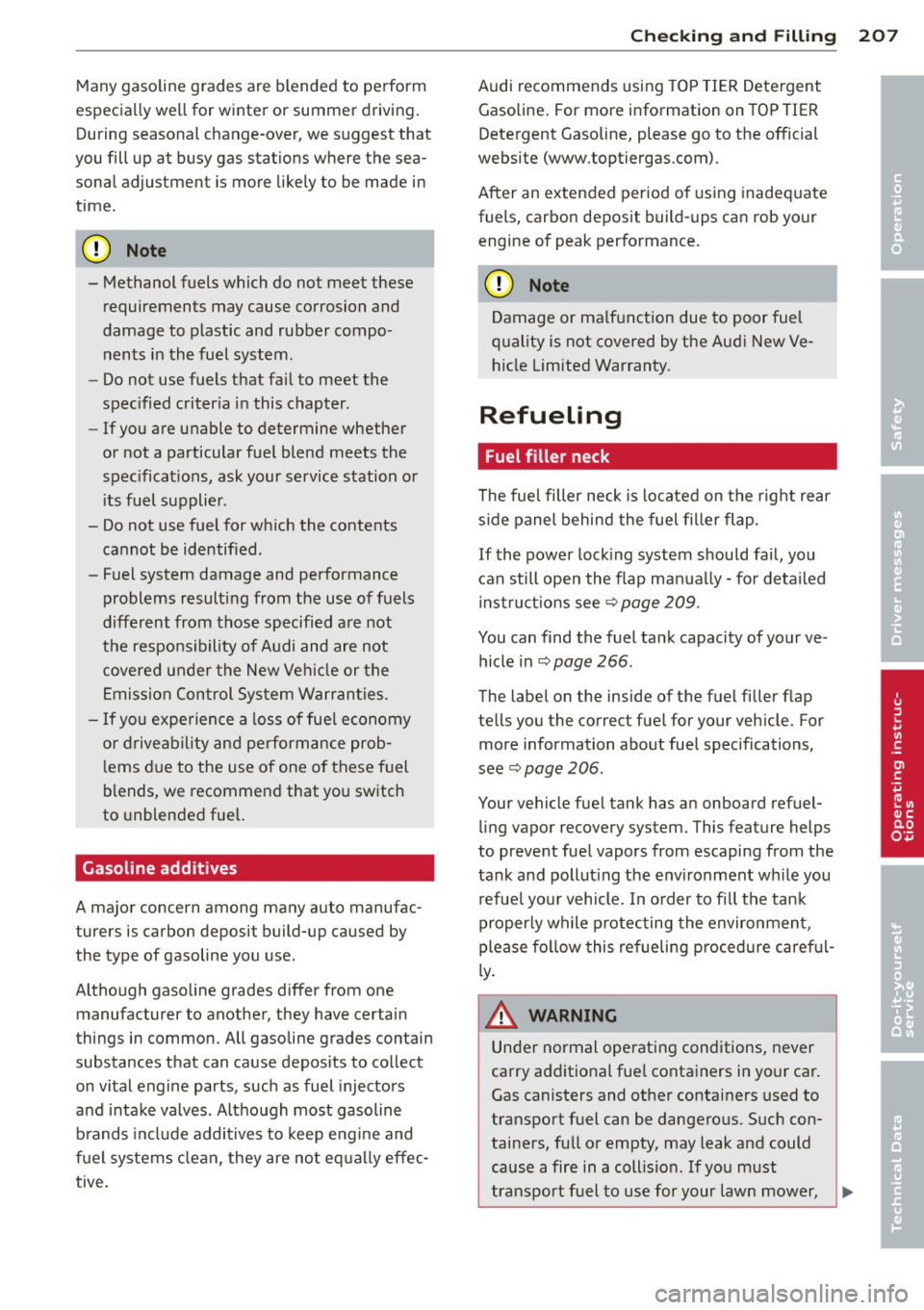
Many gasoline grades are blended to perform
especially well for winter or summer driving. During seasonal change-over , we suggest that
you fill up at busy gas stations where the sea sonal adjustment is more likely to be made in
time.
Q;) Note
- Methanol fuels which do not meet these requirements may cause corrosion and
damage to plastic and rubber compo
nents in the fuel system .
- Do not use fuels that fail to meet the
specified criteria in this chapter .
- If you are unable to determine whether
or not a particular fuel blend meets the
specificat ions, ask your service station or
i ts fuel supp lier .
- Do not use fuel for which the contents cannot be identified .
- Fuel system damage and performance
problems resulting from the use of fuels
different from those specified are not
the responsibility of Audi and are not
covered under the New Vehicle or the
Emission Control System Warranties.
- If you experience a loss of fuel economy
or driveability and performance prob
lems due to the use of one of these fuel
blends, we recommend that you switch
to unblended fuel.
Gasoline additives
A major concern among many auto manufac
turers is carbon deposit build-up caused by
the type of gasoline you use .
Although gasoline grades differ from one manufacturer to another, they have cer tain
things in common. All gasoline grades contain substances that can cause deposits to collect
on vital engine parts, such as fuel injectors
and intake valves. Although most gasoline
brands include additives to keep engine and
fuel systems clean, they are not equally effec
tive.
Checking and Filling 207
Audi recommends using TOP TIER Detergent
Gasoline . For more information on TOP TIER
Detergent Gasoline, please go to the official
website (www .toptiergas .com) .
After an extended period of using inadequate
fuels, carbon deposit build-ups can rob your engine of peak performance.
CJ) Note
Damage or malfunction due to poor fuel
quality is not covered by the Audi New Ve
hicle Limited Warranty.
Refueling
Fuel filler neck
The fuel filler neck is located on the right rear
side panel behind the fuel filler flap.
If the power locking system should fail, you
can still open the flap manually -for detailed
instructions see
c::> page 209.
You can find the fuel tank capacity of your ve
hicle in
c::> page 266.
The label on the inside of the fuel filler flap
tells you the correct fuel for your vehicle. For
more information about fuel specifications,
see
c::> page 206 .
Your vehicle fuel tank has an on board refuel
ling vapor recovery system. This feature helps
to prevent fuel vapors from escaping from the
tank and polluting the environment while you refuel your vehicle. In order to fill the tank
properly while protecting the environment,
please follow this refueling procedure careful
ly .
A WARNING ~
Under normal operating conditions, never
carry additional fuel containers in your car.
Gas canisters and other containers used to
transport fuel can be dangerous. Such con
tainers, full or empty, may leak and could
cause a fire in a collision . If you must
transport fuel to use for your lawn mower, ..,.
•
•
•
Page 210 of 288
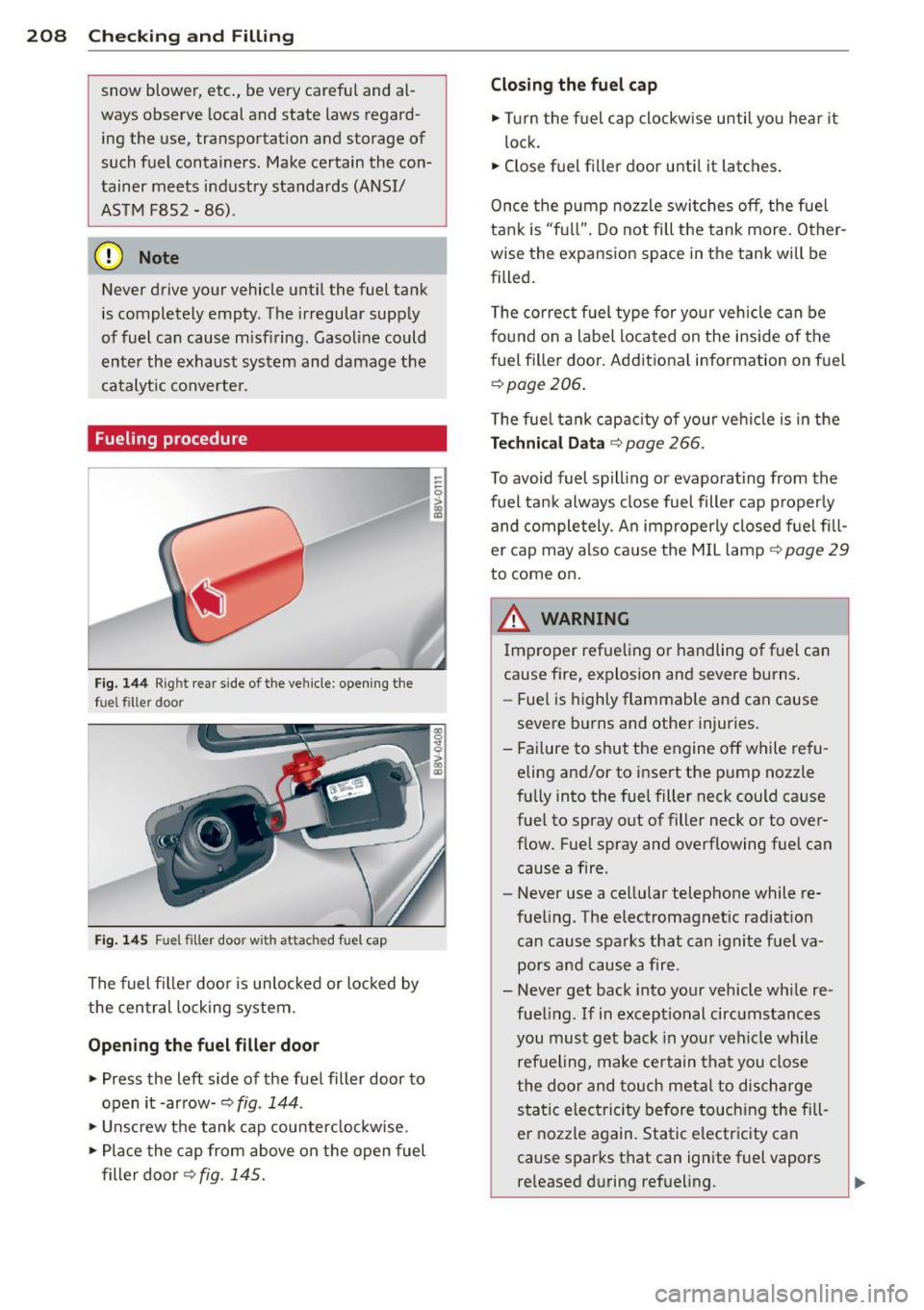
208 Checking and Filling
snow blower, etc., be very careful and al
ways observe local and state laws regard
ing the use, transportation and storage of
such fuel containers . Make certain the con
tainer meets industry standards (ANSI/
ASTM F852 -86) .
(D Note
Never drive your vehicle until the fuel tank
is completely empty . The irregular supply
of fuel can cause misfiring. Gasoline could
enter the exhaust system and damage the
catalytic converter.
Fueling procedure
Fig. 144 Rig ht rear side of the vehicle: opening the
fue l filler door
Fig. 145 Fu el filler door w ith atta ched fuel cap
The fuel filler door is unlocked or locked by
the central locking system.
Opening the fuel filler door
.,. Press the left side of the fuel filler door to
open it -arrow-
c::> fig . 144 .
• Unscrew the tank cap counterclockwise.
• Place the cap from above on the open fuel
filler door
c::> fig . 145. Closing the fuel cap
.,.
Turn the fuel cap clockwise until you hear it
lock.
.,. Close fuel filler door until it latches.
Once the pump nozzle switches off , the fuel
tank is "full". Do not fill the tank more. Other
wise the expansion space in the tank will be
filled.
The correct fuel type for your vehicle can be
found on a label located on the inside of the
fuel filler door. Additional information on fuel
c::>page206.
The fuel tank capacity of your vehicle is in the
Technical Data c::> page 266.
To avoid fuel spilling or evaporating from the
fuel tank always close fuel filler cap properly
and completely. An improperly closed fuel fill
er cap may also cause the MIL lamp
c::> page 29
to come on.
A WARNING
Improper refueling or handling of fuel can
cause fire, explosion and severe burns.
- Fuel is highly flammable and can cause
severe burns and other injuries.
- Failure to shut the engine off while refu
eling and/or to insert the pump nozzle
fully into the fuel filler neck could cause
fuel to spray out of filler neck or to
over
flow. Fuel spray and overflowing fuel can
cause a fire .
- Never use a cellular telephone while re
fueling. The electromagnetic radiation can cause sparks that can ignite fuel va
pors and cause a fire .
- Never get back into your vehicle while re
fueling . If in exceptional circumstances
you must get back in your vehicle while
refueling, make certain that you close
the door and touch metal to discharge
static electricity before touching the fill
er nozzle again. Static electricity can
cause sparks that can ignite fuel vapors released during refueling .
Page 211 of 288
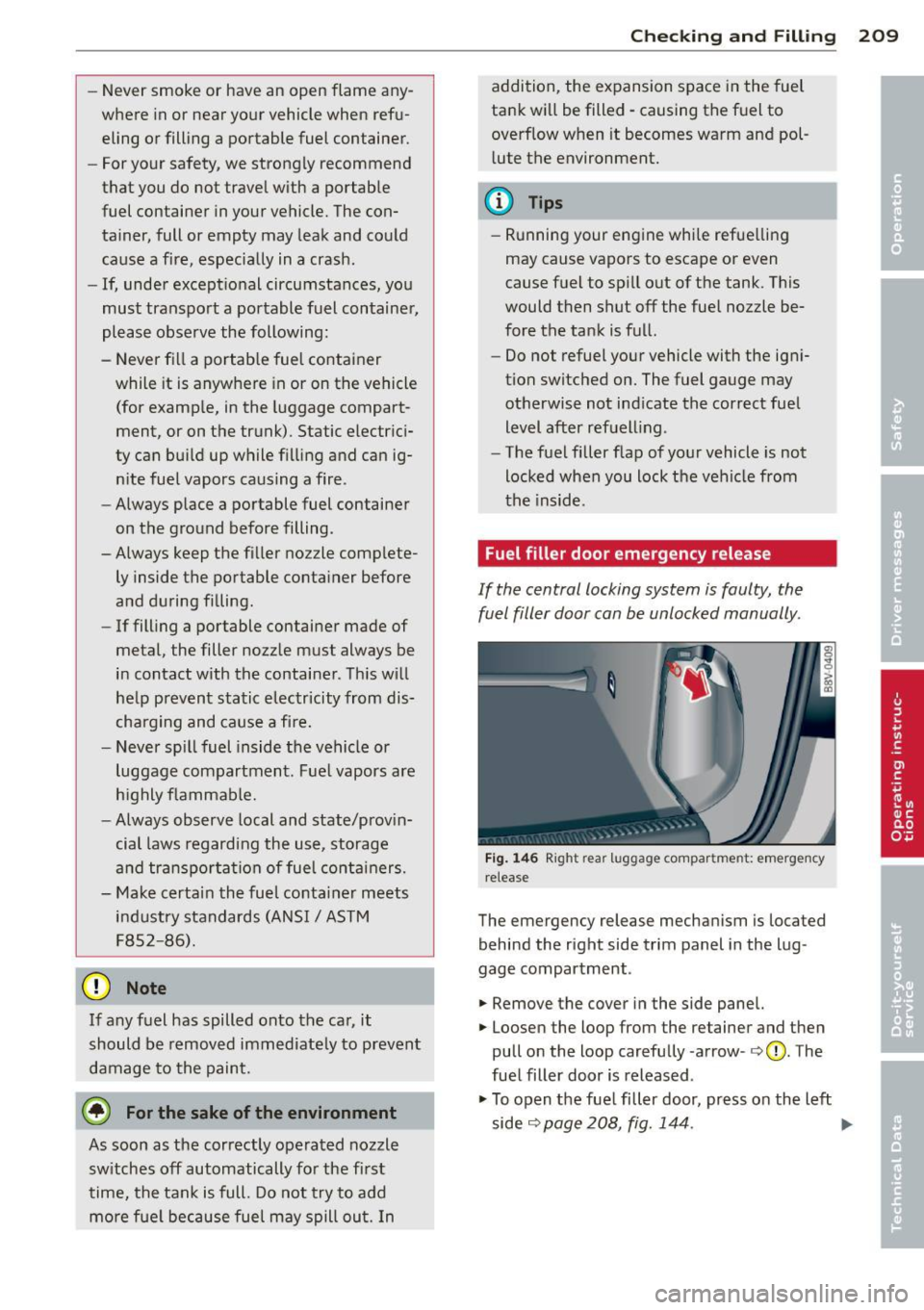
-Never smoke or have an open flame any
where in or near your vehicle when refu
eling or filling a portable fuel container.
- For your safety, we strongly recommend
that you do not travel with a portable
fuel container in your vehicle. The con
tainer, full or empty may leak and could
cause a fire, especially in a crash.
- If, under exceptional circumstances, you
must transport a portable fuel container,
please observe the following:
- Never fill a portable fuel container while it is anywhere in or on the vehicle
(for example, in the luggage compart
ment, or on the trunk). Static electrici
ty can build up while filling and can ig
nite fuel vapors causing a fire .
- Always place a portable fuel container
on the ground before filling .
- Always keep the filler nozzle complete
ly inside the portable container before
and during filling.
- If filling a portable container made of
metal, the filler nozzle must always be
in contact with the container . This will
help prevent static electricity from dis
charging and cause a fire.
- Never spill fuel inside the vehicle or
luggage compartment. Fuel vapors are
highly flammable.
- Always observe local and state/provin
cial laws regarding the use, storage
and transportation of fuel containers.
- Make certain the fuel container meets
industry standards (ANSI/ ASTM
F852-86).
(D Note
If any fuel has spilled onto the car, it
should be removed immediately to prevent
damage to the paint.
@ For the sake of the environment
As soon as the correctly operated nozzle
switches off automatically for the first
time, the tank is full. Do not try to add
more fuel because fuel may spill out. In
Checking and Filling 209
addition, the expansion space in the fuel
tank will be filled -causing the fuel to
overflow when it becomes warm and pol
lute the environment.
@ Tips
-Running your engine while refuelling
may cause vapors to escape or even
cause fuel to spill out of the tank. This
would then shut off the fuel nozzle be
fore the tank is full.
- Do not refuel your vehicle with the igni
tion switched on. The fuel gauge may
otherwise not indicate the correct fuel
level after refuelling .
- The fuel filler flap of your vehicle is not
locked when you lock the vehicle from
the inside.
Fuel filler door emergency release
If the central locking system is faulty, the
fuel filler door can be unlocked manually .
Fig. 146 Rig ht rea r lu g g ag e compar tme nt: emergency
release
The emergency release mechanism is located
behind the right side trim panel in the lug
gage compartment .
.,. Remove the cover in the side panel.
.,. Loosen the loop from the retainer and then
pull on the loop carefully -arrow -
c:>(D . The
fuel filler door is released .
.,. To open the fuel filler door, press on the left
side
c:> page 208, fig. 144 . i,..